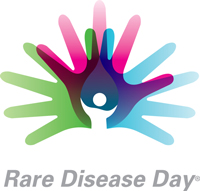

February 2014
IN THIS ISSUE:
![]()
- Maryland blood donor hits 40-year milestone
- NIH-FDA train staff on Investigational New Drug applications
- Johns Hopkins University researcher lectures on future cancer treatments through blood vessels
- Masur recalls vision of early Clinical Center leaders
- Ognibene selected to be a Master of Critical Care Medicine
- Leadership Development Brown Bag Series launches in February
- Senior advisor for biotechnology development, pharmacy leader retires
- CC Salutes
- Local school brings joy to pediatric patients
- Upcoming Events
Print this Issue ![]() (350 KB)
(350 KB)
ABOUT CC NEWS:
![]()
Published monthly by the Office of Communications and Media Relations. News, article ideas, calendar events, letters, and photographs are welcome. Submissions may be edited.
Clinical Center News
National Institutes of Health
Building 10, 10 Center Drive
Room 6C-420,
Bethesda, MD 20892-1504
Tel: 301-594-5789
Fax: 301-402-4984
Molly.hooven@nih.gov
QUICK LINKS:
![]()
Maryland blood donor hits 40-year milestone
 |
Sara 'Lu' Colabucci |
In 1974, a bumper sticker sparked Sara 'Lu' Colabucci to become a donor at the NIH Blood Bank. This year marks her 40th anniversary donating, and during that time, she's provided more than 310 platelet and granulocyte donations.
Platelets are small cells that help the blood to clot and granulocytes are a type of white blood cell that helps the body fight infections.
"It started with somebody having a bumper sticker [about donating platelets at the NIH] and I thought, now that's a good thing to do for people," said Colabucci. "I just kept coming back and coming back like a bad penny. You all got stuck with me."
Colabucci, who grew up in Takoma Park, now lives in Ocean City and embarks on a three-hour drive nearly every month to give blood at the NIH. A donation facility in Dover, Del. may be closer to Colabucci, but she said, "I made these people my family; I can't go to Dover! I don't mind the drive."
Hal Wilkins, recruitment supervisor in the NIH Clinical Center Department of Transfusion Medicine, and fellow staff members surprised her with a cake when she came to donate a day before her 80th birthday in December 2013.
"Lu is currently the oldest of our female platelet donors continuing to donate on a regular basis. She's assisted more than 600 patients with life-sustaining platelet donations," Wilkins said. "In the group of generous individuals who donate platelets at the NIH, Lu shines through as unique in a constellation of wonderful people."
While laughing and reminiscing with her 'NIH family', she remains unbelievably humble. "I don't want to be thanked. It's something everybody should do," Colabucci said.
During the 300 miles back and forth to donate, Colabucci proudly displays her NIH Blood Bank magnets on the car. "I put them on the front and the back of my fenders, and I go through town. I make sure those things are on," she said.
Yet, she still prefers the original inspiration that came four decades ago. "I've got to let them [NIH] know that if they ever get a bumper sticker, I'd love to have them!"
View more information on donating blood.
NIH-FDA train staff on Investigational New Drug applications
Representatives from the Food and Drug Administration's (FDA) Center for Drug Evaluation and Research (CDER) and the Clinical Center held a training course for NIH intramural researchers on how to compile and complete an investigational new drug application Dec. 12, 2013. The course was designed by the Clinical Center and the FDA CDER Joint Task Force.
Investigational new drug applications are sent to the FDA when researchers intend to test a promising new pharmaceutical product as an investigational agent. Clinical investigators intending to test a new compound must provide the FDA with information about product manufacturing, non-clinical studies to support safety of administering the product, previous clinical experience with an explanation of intended use in the proposed clinical protocol and the investigator's qualifications, among other parts of an application.
"It is critical if you want to do work on drug discovery that you understand the regulatory requirements, the ethical mandates and mechanisms available [to work] with our colleagues at the FDA," said Clinical Center director Dr. John I. Gallin.
Once a researcher submits an initial investigational new drug application, the FDA has 30 days to review and decide whether the proposed clinical investigation is safe to proceed.
"We have a very important role in overseeing the clinical trial process," said FDA CDER's Office of New Drugs director Dr. John Jenkins. "We have a responsibility to protect subjects in clinical trials."
During the clinical trial, the researcher is responsible for informing the FDA about any changes in the protocol and product side effects observed. Once the trial ends, researchers must file a report describing their results.
In some cases, the FDA will grant permission to use investigational new drugs outside of a clinical trial.
If a patient or a group of patients has a serious condition with no available alternative treatment options, are ineligible for clinical trials and meet other established criteria, their treating physicians can request expanded access to an investigational new drug by filing an application to the FDA.
Established in 2012, this Joint Task Force promotes early engagement between FDA regulatory scientists and NIH investigators. In October 2013, the Joint Task Force posted training materials on the FDA website to provide regulatory information about the investigational new drug application process.
Dr. Juan Lertora, Clinical Pharmacology Program director in the Office of Clinical Research Training and Medical Education at the NIH Clinical Center, and Dr. Larissa Lapteva, of the FDA CDER Office of New Drug's Rare Disease Program, co-chaired the training course.
Johns Hopkins University researcher lectures on future cancer treatments through blood vessels
Dr. Jean-Francois Geschwind, a researcher at Johns Hopkins University School of Medicine [disclaimer], discussed progress made in delivering cancer treatments to patients with liver cancer for the John Doppman Memorial Lecture for Imaging Sciences Dec. 18, 2013.
Geschwind, director of Interventional Radiology at The Johns Hopkins Hospital, hopes to eliminate the debilitating effects of cancer treatment patients face by fast-tracking anti-cancer drugs directly to the tumor.
He seeks to deliver chemotherapy agents to liver tumors by directly channeling the drugs through a blood vessel that flows to the liver. The procedure would lessen the effects seen through most chemotherapy sessions such as nausea, fatigue and hair loss.
Geschwind is also a professor of radiology, surgery and oncology at Johns Hopkins University School of Medicine.
![]()
Masur recalls vision of early Clinical Center leaders
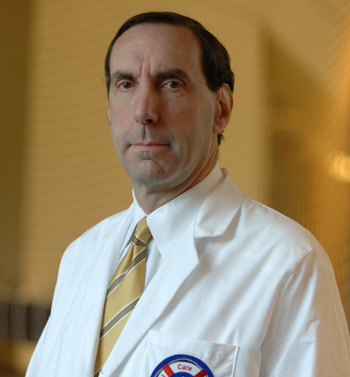 |
Dr. Henry Masur has served NIH for more than thirty years. |
Since 1989, Dr. Henry Masur has been chief of the Critical Care Medicine Department at the NIH Clinical Center. On Dec. 23, 2013, he shared his reflections on the history of the Clinical Center. Read the full interview at our 60th anniversary website.
Well certainly my father [Dr. Jack Masur, the first director of the Clinical Center] was very impassioned about the development of the hospital here, and about recruiting people to NIH, so that NIH was a regular topic of conversation even among the family: the people he was recruiting, the building, the renovations of the building.
I was very impressed by how enthusiastic he and his friends were about their jobs: they felt they were doing something worthwhile for the public good. It's really that enthusiasm that he and his friends had for medicine, for science, their enthusiasm for the kinds of people they met...that I think I picked up on.
I was not one of these people who know from an early age that they're going to be a scientist of some sort. I had had some misgivings about coming to NIH. I wanted to be sure I was evaluated on my own merits and not as a legacy hire, but it seemed like NIH was a grand opportunity; and in fact 30 years later, I still think it was a great opportunity, and it still is a good opportunity, because of all the things you can do at NIH to build programs.
The best thing about working at NIH is that it's a science-based organization where good ideas usually carry the day. The accomplishments of NIH intramural in HIV/AIDS and critical care over the last 30 years speak for themselves. The intramural environment allowed these programs to flourish by encouraging collaboration, collegiality and vision. The research at NIH helps children and adults, those with common diseases and rare diseases. It really enhances everyone's health.
Organizations bestow award, leadership role to Masur In late 2013, Masur received the John E. Maher Memorial Laureate Award [disclaimer] from the American College of Physicians, D.C. Chapter, in recognition of his outstanding achievements as a clinical investigator, clinician, educator and medical leader. He was also appointed co-chair of the Guideline on Hepatitis C Committee for the Infectious Disease Society of America [disclaimer] and the American Association for the Study of Liver Diseases [disclaimer]. |
Ognibene selected to be a Master of Critical Care Medicine
 Dr. Frederick P. Ognibene (center), deputy director of Educational Affairs and Strategic Partnerships and director of the Office of Clinical Research Training and Medical Education was named Master of Critical Care Medicine by the Society of Critical Care Medicine. He was honored for his outstanding contributions to leadership, research and education in critical care. Sandra Blosser, M.D., chancellor, American College of Critical Care Medicine (left) and Carol Thompson, Ph.D., president, Society of Critical Care Medicine (right) presented the award at the 43rd Critical Care Congress [disclaimer] Jan. 11.
Dr. Frederick P. Ognibene (center), deputy director of Educational Affairs and Strategic Partnerships and director of the Office of Clinical Research Training and Medical Education was named Master of Critical Care Medicine by the Society of Critical Care Medicine. He was honored for his outstanding contributions to leadership, research and education in critical care. Sandra Blosser, M.D., chancellor, American College of Critical Care Medicine (left) and Carol Thompson, Ph.D., president, Society of Critical Care Medicine (right) presented the award at the 43rd Critical Care Congress [disclaimer] Jan. 11.
Leadership Development Brown Bag Series launches in February
The Clinical Center Office of Workforce Management and Development will launch the 2014 Clinical Center Leadership Development Brown Bag Series: Leveraging Diverse Perspectives on Feb. 18.
The initial session is titled Exploring Diverse Perspectives on the Furlough. It will include a panel consisting of Clinical Center employees, supervisors and department heads who will share their different experiences and lessons learned during the government shutdown. Due to snow, the January session has been rescheduled for June 4.
The sessions will include topics such as recognizing micro-inequities in the workplace, examining the impact of power differentials and mindfulness.
All sessions are held in the Medical Board Room, 4-2551, at noon. Staff can call 301-594-9548 or visit the intranet (NIH Staff Only) for more information. Registration is not required.
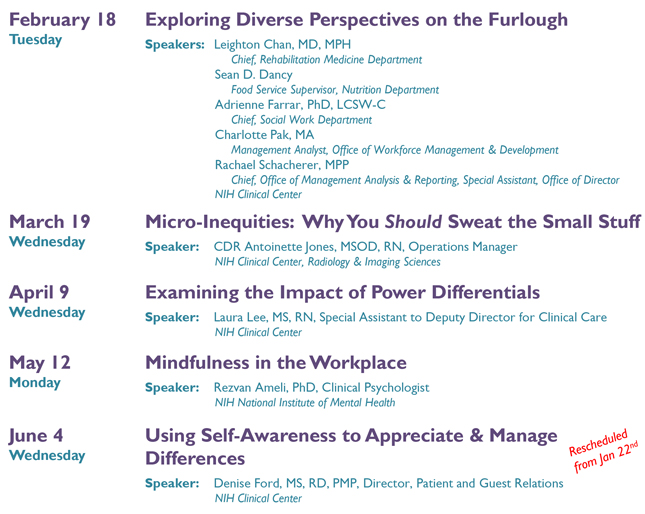
Senior advisor for biotechnology development, pharmacy leader retires
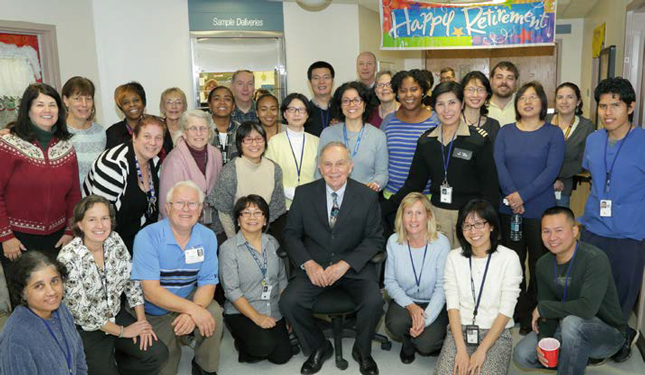 |
Dr. Joseph Gallelli (center) and Department of Transfusion Medicine friends gather at the retirement party. |
On Jan. 3, Dr. Joseph Gallelli retired as senior advisor for biotechnology product development in the Clinical Center's Office of the Director. In this role, he supported and assisted in the development and growth of the Cell Processing Section in the Transfusion Medicine Department that manufactures cellular therapy products for the treatment of Clinical Center patients.
Gallelli began his NIH career in 1961 as a staff pharmacist after completing graduate studies at Temple University where he earned a master's and Ph.D.
Soon after, he moved into the position of chief of the Pharmaceutical Development Section and by 1970 he became chief of the Pharmacy Department. In 1995, after completing a long and distinguished career in pharmacy, Gallelli was named senior advisor for biotechnology product development.
Gallelli has been a leader in helping to transform pharmacy into a clinical profession with a focus on patient care and improving drug therapy outcomes.
"[He] led an impressive and important career in decades of work for the NIH and the Department," said Department of Health and Human Services Secretary Kathleen Sebelius when she honored Gallelli for 50 years of federal service in 2011.
In 1974, Gallelli published the first textbook on the compatibility and chemical stability of drugs used in the preparation of intravenous additive solutions. The book, Parenteral Drug Information Guide, was based on years of original research in his lab. That same year, he established the first post-graduate hospital pharmacy residency program at the Clinical Center and has mentored numerous pharmacists and scientists who have become leaders in their own right.
He also published major guidelines and recommendations on the safe handling, chemical inactivation and disposal of injectable antineoplastic drugs.
Gallelli introduced the Unit Dose Drug Distribution System, which has become the standard in the U.S., and developed the first centralized intravenous admixture service for preparing sterile injectable products.
In 1982, he established the Clinical Pharmacokinetics Research Laboratory to analyze drug concentrations in biological specimens, determine the pharmacokinetic properties of investigational drugs and perform therapeutic drug monitoring to assist in individualized dosing of medications.
Gallelli has held leadership positions in numerous organizations in the U.S. and abroad, including the American Society of Health-System Pharmacists, U.S. Pharmacopeia and International Pharmaceutical Federation.
He has received awards such as the U.S. Public Health Service George Archambault Public Health Service Career Achievement Award in Pharmacy, the American Public Health Association Distinguished Federal Pharmacist Award and the Association of Military Surgeons of the U.S. Andrew Craigie Award.
In his retirement, Gallelli will write about the history of pharmacy at the NIH, take Italian language lessons, paint Byzantine-style icons and travel.
Gallelli will not be too far away from NIH, though. He's signed on to work as a special volunteer.
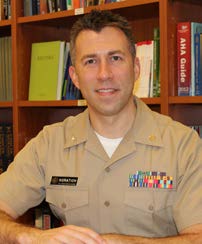 |
Capt. Chad Koratich, senior nurse consultant for research and practice development, Nursing Department. |
The Clinical Center is proud of staff who served our country in the military. In this story, we interviewed a veteran employee on his transition from the military and his career. Read other veteran interviews.
Capt. Chad Koratich served in the US Army Nurse Corps [disclaimer] from 1993 to 1999 upon receiving his commission via a three-year Reserve Officers' Training Corps commission scholarship. His service included tours at Walter Reed Army Medical Center in Washington, a US Army hospital and a medical unit in Seoul, South Korea and Lyster Army Hospital in Alabama. He joined the US Public Health Service Commissioned Corps and became part of the Clinical Center in 1999.
How did you become a Clinical Center employee?
As I was transitioning out of the Army in April 1999, my chief nurse told me about the US Public Health Service Commissioned Corps. Knowing my partner and I were coming back to the National Capital Area, I soon realized through my job search that Public Health Service officers could be assigned at the Clinical Center. I then began the process of applying to both the Corps and Clinical Center. The process took about six months. Joining the Corps and working at the Clinical Center were two of the best career decisions I've ever made.
What inspired you to want to work here?
In all honesty, until I was leaving the Army, I really didn't know much about the NIH and knew even less about the Clinical Center. However, I knew that I wanted to work with the HIV/AIDS population, and through my job research, I discovered there was a very robust HIV/AIDS research program here. I interviewed for a clinical research nurse position on the infectious disease inpatient unit where I worked for seven months before accepting a position as a research case manager with the Adult Infectious Disease Clinic which focused mostly on HIV/AIDS studies.
Was it difficult transitioning from the military into the Clinical Center?
In the military, you are told what your job will be as well as where and when to report. You have some leeway to request assignments but it is ultimately up to the needs of the service. So the process of searching for my own position was a bit daunting. One of the aspects of the military I most loved and appreciated was the sense of unit and esprit de corps. Coming to the NIH and the Clinical Center was much different. As a uniformed service member working in a civilian facility, that feeling of esprit de corps is less palpable. Thankfully, being a nurse, you quickly develop strong relationships with your peers, and I've been very lucky to have some of the most amazing co-workers here at the Clinical Center, many of whom have become close friends.
What are some of the opportunities you have had here at the Clinical Center?
I have been extremely fortunate during my 14 years at the Clinical Center to have managers and mentors who have guided and enabled me to continually advance in my profession. I had the rewarding experience of fulfilling my goal and working with the HIV patient population for eight years. I have also been able to assume positions of increasing responsibility and leadership with the nursing department. I served as chair of the Nursing Practice Council. This group's focus is to govern the advancement of evidence-based nursing practice for the Clinical Center. Currently, I have the honor of serving as the director of the Veterans Incentive Program which employs former medics and corpsmen as full-time patient care technicians while providing time and funding support to pursue degrees in nursing.
How do you think other veterans can benefit from joining NIH?
I think the NIH offers a great environment for veterans. There is strong support at all levels of leadership for providing opportunities to veterans. NIH's location in the National Capital Area with proximity to several military facilities, universities and support services is also a great benefit for veterans.
Local school brings joy to pediatric patients
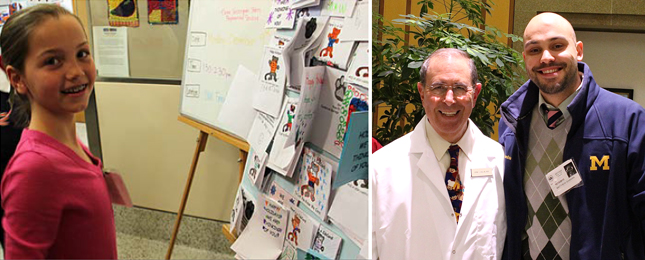
Morgan Riso (left), a fifth grader at Bethesda's Carderock Springs Elementary School, and more than 35 first through fifth graders from the Student Government Association delivered handmade holiday greetings cards to NIH Clinical Center pediatric unit December 2013. Dr. John I. Gallin, Clinical Center director, welcomed Matthew Ghaman, Carderock teacher and SGA advisor (right), and later talked to students and parents about the research at the Clinical Center. The schools SGA raised $5,214.50 last year for the Clinical Center Patient Emergency Fund, which provides periodic financial assistance to selected patients and family members.
Upcoming Events
All events listed below will be streamed and archived.
Contemporary Clinical Medicine: Great Teachers Lecture; NIH Clinical Center 2014 Distinguished Clinical Research Scholar & Educator in Residence Lecture
The conundrum of early life antibiotics
Feb. 12, 2014; Noon - 1:00 p.m.
Lipsett Amphitheater
Presented by Martin J. Blaser, M.D., New York University Langone Medical Center.
NIH Director's Wednesday Afternoon Lecture Series
Congenital heart disease: Many genes lead to a broken heart
Feb. 12, 2014; 3:00 p.m. - 4:00 p.m.
Masur Auditorium
Presented by Christine Seidman, Harvard Medical School.
Clinical Center Grand Rounds Lecture
The use of mesenchymal stem cells to improve LV function as an adjunct to surgical revascularization; Psoriasis inflammation and its association with cardiovascular disease
Feb.19, 2014; Noon - 1:00 p.m.
Lipsett Amphitheater
Presented by Keith Horvath, M.D., NHLBI and Nehal Mehta, M.D., NHLBI.
NIH Director's Wednesday Afternoon Lecture Series
Induced pluripotent stem cells and the impact of genomic variation on psychiatric disorders
Feb. 19, 2014; 3:00 p.m. - 4:00 p.m.
Masur Auditorium
Presented by Flora Vaccarino, Yale University.
Clinical Center Grand Rounds Lecture
The calculus of calories: What mathematics can teach us about obesity; Artificial sweeteners and obesity: More than an association
Feb. 26, 2014; Noon - 1:00 p.m.
Lipsett Amphitheater
Presented by Kevin Hall, Ph.D., NIDDK and Kristina I. Rother, M.D., NIDDK.
NIH Director's Wednesday Afternoon Lecture Series
Giant chromosomes and deep sequences: What the frog egg tells us about RNA transcription
Feb. 26, 2014: 3:00 p.m. - 4:00 p.m.
Masur Auditorium
Presented by Joseph Gall, Carnegie Institute for Science.
Rare Disease Day event set for Feb. 28
The NIH Clinical Center continues to invest in rare disease research and in the development of treatments for rare diseases. In celebration of the seventh Rare Disease Day, the Clinical Center will host a symposium to open communication about rare diseases, the challenges encountered by those affected and the importance of research to develop diagnostics and treatments. The symposium will be held Feb. 28, 7:30 a.m. - 5:00 p.m., in Masur Auditorium. Feb. 29, which does not occur this year, is the actual date of Rare Disease Day, since it is a rare occurrence. Attendance is free and open to public. Register online and if you want to display a poster/exhibit, include that information when you register. In association with the Global Genes Project [disclaimer], which uses "jeans and genes" to raise awareness, attendees are encouraged to wear their favorite pair of jeans. Activities are supported by the NIH Office of Rare Diseases Research in the National Center for Advancing Translational Sciences, the NIH Clinical Center, other NIH Institutes and Centers; the Food and Drug Administration's Office of Orphan Product Development; other Federal Government agencies; the National Organization for Rare Disorders; and the Genetic Alliance. Register and view more information.
|
NOTE: PDF documents require the free Adobe Reader.
 The information on this page is archived and provided for reference purposes only.
The information on this page is archived and provided for reference purposes only.
